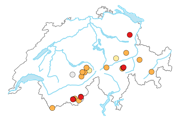The "Current avalanches" view on whiterisk.ch displays manually mapped avalanches. These are reported by SLF observers and the public. This information is neither verified nor corrected and may be inaccurate.
Attributes displayed ¶
As well as the avalanche location, the avalanche size, avalanche type, trigger type and avalanche moisture are displayed.
The information about avalanche location is of varying quality. Where possible, a starting point or the highest point of the fracture line is shown. In the absence of starting points, other available location information is used. The avalanche points may therefore sometimes be located in flatter terrain.
The trigger type provides information about the additional load required to trigger an avalanche.
Avalanche moisture refers to the liquid water content of the snowpack in the starting zone.
Interpreting the data ¶
The "Current avalanches" displayed are only some of the avalanches that occur. While in some areas a large proportion of avalanches may be reported at times, in others there is no avalanche recording at all. If no avalanches have been reported in an area, there may be various reasons for this:
- Favourable avalanche situation
- Poor visibility
- No active SLF observers in the area
- Uninhabited, poorly visible area
- Few winter sports enthusiasts in the area and therefore no feedback from the public
Consequently, areas with few or no avalanche observations cannot automatically be considered less dangerous. Conversely, in areas with many recent observations, it can be assumed that avalanche danger is present, since there are few clearer signs of avalanche danger than avalanches themselves. However, the trigger type must also be taken into account. In ski resorts in particular, large numbers of avalanches are often displayed. These are triggered by avalanche blasting (i.e. explosions to protect infrastructure from avalanches) and thus by high additional load.
Seen an avalanche? ¶
If you have observed a recent avalanche or even triggered one yourself, please report it using the feedback form. Your observation will help to improve the avalanche bulletin.
